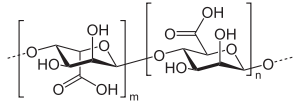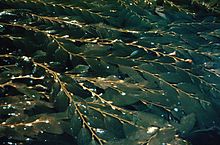Alginic acid
| Structural formula | |||||||||
|---|---|---|---|---|---|---|---|---|---|

|
|||||||||
| General | |||||||||
| Surname | Alginic acid | ||||||||
| other names |
|
||||||||
| CAS number | 9005-32-7 | ||||||||
| Monomers / partial structures | α - L -uluronic acid and β - D -mannuronic acid | ||||||||
| ATC code | |||||||||
| Brief description |
beige solid |
||||||||
| properties | |||||||||
| Physical state |
firmly |
||||||||
| density |
1.79 g cm −3 |
||||||||
| Melting point |
300 ° C |
||||||||
| solubility |
insoluble in cold water, slightly soluble in boiling water |
||||||||
| safety instructions | |||||||||
|
|||||||||
| Toxicological data | |||||||||
| As far as possible and customary, SI units are used. Unless otherwise noted, the data given apply to standard conditions . | |||||||||
Alginic acid , also known as algin , is produced by brown algae and some bacteria (e.g. Azotobacter ). In the alga it is the structural element of the cell walls. The intercellular gel matrix gives the alga both flexibility and strength. Algin is a by-product in the extraction of iodine from seaweed using the wet process. However, it is also extracted directly from the brown algae for use in the food, pharmaceutical and cosmetic industries. The salts of alginic acid are commonly referred to as alginates . Alginate is mainly used as a thickening or gelling agent .
Extraction and manufacture
The extraction of brown algae takes place z. Sometimes by special trawlers that “harvest” the seabed. However, it is still common for the algae to be collected on the beach after storms. Laminaria , Ecklonia , Macrocystis , Lessonia , Ascophylum and Durvillea serve as algae genera for the commercial production of alginate . The collected algae are roughly freed from dirt and impurities and dried. After drying, they are delivered to the alginate producer. In a first process step, the algae are washed and ground. The alginate is then extracted and purified using filtering and precipitation steps. In addition to sodium alginate (E 401), which is most commonly used in the food industry, the following salts of alginic acid are also found: potassium alginate (E 402), ammonium alginate (E 403), calcium alginate (E 404) and propylene glycol alginate (PGA, E 405).
structure
Alginate is a polysaccharide consisting of the two uronic acids α - L -guluronic acid (GulUA) and β - D- mannuronic acid (ManUA), which are 1,4-glycosidically linked in alternating proportions to form linear chains. It forms homopolymeric areas in which mannuronic acid or guluronic acid are present as blocks. These blocks are called GG or MM blocks. In the area of the GG and MM blocks there is a kind of fold structure that plays an essential role in gelation. The GG blocks in particular form a regular zigzag structure. The mean molar mass is 48,000–186,000 g · mol −1 .
function
Alginate can lead to an increase in viscosity in solutions with a low calcium content . The primary function, however, is gelation. Gelation occurs as a result of calcium ions being embedded in the zigzag structure of the GG blocks. The zigzag structure of another alginate molecule is then deposited on this zone. This leads to the formation of three-dimensional structures. Since the calcium lies in this structure like an egg in the box, this model is also known as the "egg box model" or "egg box model". Because this reaction with calcium occurs very suddenly, various methods are used in practice to allow the reaction to proceed in a controlled manner. For this purpose, sparingly soluble calcium salts are often used, which gradually release the calcium by means of slow acidification. In addition, sequestrants are also used, which can bind part of the calcium. Instead of calcium, other divalent cations , e.g. B. barium can be used to gel the alginate. The cross-linking of the alginate with bivalent cations can, under certain conditions, form pores that are perpendicular to the gel formation.
The salts of alginic acid are water-soluble ; due to the high viscosity of the resulting solution, it is often necessary to stir overnight with gentle heating in order to avoid lump formation. 1 to 2 percent solutions gel spontaneously and quickly on contact with sufficiently concentrated calcium solutions. Algin can be used as a finishing agent for textiles and fabrics as well as for the production of photographic papers . As a food additive , it has the designation E 400.
Applications
Food technology
In the food industry , alginates are used as emulsifiers , gelling , coating or thickening agents. In the EU , alginic acid and its sodium, potassium, ammonium and calcium salts are approved as food additives with the numbers E 400 to 405 for all products approved for additives - including " organic " products. Alginates are not absorbed by the body and are considered harmless. However, larger amounts can reduce the absorption of calcium and trace elements such as iron, and animal experiments have shown a slight impairment of protein digestion. However, there are no health concerns.
Alginates are often found in diet and light products, baked goods , frozen products, mayonnaise , salad dressings, ice cream , in canned meat and vegetables, and soups. They are also used in the manufacture of processed cheese in combination with sodium citrate (E 331) and sodium phosphate (E 339).
Alginates are also used in what is known as molecular cuisine , where they are used to make artificial or fruit caviar .
It is also used in cosmetic products.
medicine
Calcium alginate compresses are used in medicine to treat wounds. Calcium alginate prevents the dressing material from sticking to the wound by exchanging Na + ions from the wound secretion for Ca 2+ and in the associated swelling process forms a gel that keeps the wound moist and promotes wound healing.
In surgery , alginate is also used as a wound dressing or wound filler, in particular to clean and heal chronic wounds.
Alginate is also used as a biomaterial . By encapsulating human cell tissue with alginate, it is possible to store foreign material such as donor cells without them being recognized and destroyed by the immune system. The cells then take an active part in the recipient's metabolism. So z. B. insulin-producing cells are transferred from donors to patients with diabetes, who are then no longer dependent on syringes.
Alginate is also used as a drug against heartburn , making use of the fact that the active ingredient is not metabolized and forms a physical barrier between acidic stomach contents and the esophagus. Together with other constituents (calcium carbonate / potassium hydrogen carbonate), it forms a tough foam that lays on the contents of the stomach and thus prevents reflux.
In the past, alginate was often used in laboratories, especially in cell culture . Its property of gelling by adding calcium and liquefying it again after complexing the calcium (e.g. using EDTA ) enables the temporary culture of cells in three-dimensional structures and then the recovery of the cells without enzymatic, thermal or mechanical damage as it often happens with other gels.
Dentistry
Alginate is often used in dental practice to take impressions of the rows of teeth. As an impression material, alginate is physiologically safe and allows impressions to be made with acceptable accuracy and attention to detail. If it is not processed properly, the alginate impression dries out and becomes unusable. (For precision impressions, however, impression materials with a high level of detail and definition are used, such as elastomers such as polyethers and silicones). The impression material is placed in the mouth in suitable carriers made of metal or plastic (so-called impression trays ). In addition to sodium alginate, the impression material commonly used in dentistry usually also contains calcium sulfate ( gypsum ), sodium phosphate as a retarder and a large proportion of kieselguhr (diatomaceous earth).
Furthermore, alginate solutions are used to isolate materials from one another, i. i.e., to prevent these substances from combining with each other. In dental technology , for example, a plaster model is coated with an alginate solution so that a plastic prosthesis made on this model can then be easily removed from the plaster model (isolation of plaster from plastic).
It is also a component of adhesives for dentures .
Body impressions
Alginate is used by artists in the area of body impressions . The material is applied over a large area to the body part to be molded. Within a few minutes, the alginate sets into a silicone-like mass. A few more layers of plaster of paris bandages are then spread on the solidified alginate in order to maintain the proportions and to stabilize the shape for later pouring. The plaster bandages also harden very quickly, so that the negative form can be carefully loosened and removed from the body shortly afterwards. By using alginate, a very detailed and pore-accurate impression is achieved. Then the plaster of paris is mixed and the negative form is poured over the entire surface. After a drying time of around 24 hours, the positive impression can then be removed from the alginate-plaster shell and then processed further.
Textile printing
Alginate is used as a thickener in textile printing.
Web links
- zahniportal.de: Brief summary of Alginate and Heraeus Alginate Guide - Use and processing in dentistry
Individual evidence
- ↑ Alginic acid data sheet at AlfaAesar, accessed on June 19, 2019 ( PDF )(JavaScript required) .
- ↑ George Wypych: Handbook of Polymers . Elsevier, 2016, ISBN 978-1-927885-11-6 , pp. 269 ( limited preview in Google Book search).
- ↑ a b c data sheet Alginic acid from brown algae, from Sigma-Aldrich , accessed on June 19, 2019 ( PDF ).
- ^ A b Hermann Ammon (Ed.): Hunnius Pharmazeutisches approximately . 8th edition. de Gruyter, Berlin 2004, ISBN 3-11-015792-6 .
- ↑ Entry on alginic acid in the ChemIDplus database of the United States National Library of Medicine (NLM) .
- ↑ The chemical structure of alginic acid ( Memento of the original dated June 30, 2007 in the Internet Archive ) Info: The archive link was inserted automatically and has not yet been checked. Please check the original and archive link according to the instructions and then remove this notice. (engl.).
- ↑ How Gaviscon works , accessed on July 26, 2018.
- ↑ K. Masuda, RL Sah, MJ Hejna, EJ Thonar: A novel two-step method for the formation of tissue-engineered cartilage by mature bovine chondrocytes: the alginate-recovered-chondrocyte method. In: J Orthop Res. 21 (1), Jan 2003, pp. 139-148. PMID 12507591 .
